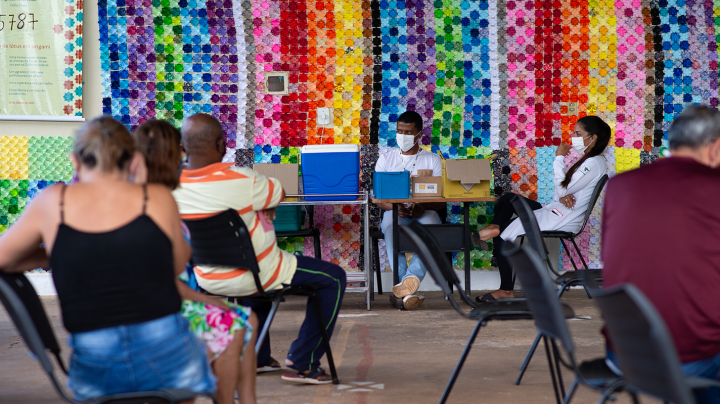How the COVID-19 Vaccine Rollout Is Being Handled Across Latin America

People wait to receive a dose of coronavirus (COVID-19) vaccination in front of the panel in honor of the fatal victims of the disease amidst the coronavirus pandemic in Centro de Saúde 07, on March 29, 2021 in Brasilia Ceilândia, Brazil. Photo by Andressa Anholete / Getty Images
In America, states are easing into lighter restrictions, and in some cases full on lifting them. While more and more vaccines are being distributed every day, top health officials continue to urge us to not get too comfortable just yet. On top of new variants of the virus popping up, issues with supplies, competition, and differing state restrictions have put America and its people behind and at risk.
This situation isn’t exclusive to America. Countries all over the world have faced much of the same obstacles. When it comes to getting shots in the arms of its citizens, Latin America has struggled.
Here’s a look at the percentages of adults across Latin America who have received the first COVID-19 vaccine dose, according to the Economist: Venezuela–0.1%, Ecuador–1.4%, Peru–2.4, Colombia–4.1%, Mexico–7.0%, Brazil–8.9% and Chile–45%
In Peru for example, the country has been fraught with scandal surrounding the vaccine itself. While Americans initially went with Pfizer and AstraZeneca for vaccines, Peru went with the Chinese Sinopharm. This was largely done so that the country could ensure it had supply. The distrust came earlier this year when news of Peru’s government and members of their family used their position to get doses of the vaccine as far back as last October. Interim President Francisco Sagasti said, “We reiterate our indignation and disappointment after being informed that 487 people, including many senior officials, took advantage of their position to be immunized with the Sinopharm vaccines, which came as a complement to those used in clinical trials in our country.”
Government is also a big reason for the low numbers in Brazil. There, Presidente Jair Bolsonaro has largely and repeatedly questioned healthcare leaders in the country. Bolsonaro has even gone as far as going to Brazil’s Supreme Court to keep the country’s states from imposing nightly curfews-a request that was later denied. As of today (March 29), Brazil is coming off a record setting 100,000 new cases in a single day. Moreover the country has recorded 24% of COVID-19 deaths worldwide in the last 14 days, according to Johns Hopkins University data.
But, the news isn’t all bad. Chile has all but become the official model for distribution rollout. Part of their success has to do with the speed in which they responded to the virus. First, they didn’t wait for their neighboring Latin American countries to decide how to proceed. Chile began hosting initial vaccine trials. This allowed them to make connections early and helped with their negotiation of their chosen vaccine. Another huge reason for their success is they started their vaccine marketing campaign early. Word from the government started as far back as December of 2020. Currently Chile has secured three different vaccines and is looking to add their fourth.